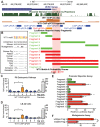WT1 targets Gas1 to maintain nephron progenitor cells by modulating FGF signals
- PMID: 25804736
- PMCID: PMC4378252
- DOI: 10.1242/dev.119735
WT1 targets Gas1 to maintain nephron progenitor cells by modulating FGF signals
Abstract
Development of the metanephric kidney depends on tightly regulated interplay between self-renewal and differentiation of a nephron progenitor cell (NPC) pool. Several key factors required for the survival of NPCs have been identified, including fibroblast growth factor (FGF) signaling and the transcription factor Wilms' tumor suppressor 1 (WT1). Here, we present evidence that WT1 modulates FGF signaling by activating the expression of growth arrest-specific 1 (Gas1), a novel WT1 target gene and novel modulator of FGF signaling. We show that WT1 directly binds to a conserved DNA binding motif within the Gas1 promoter and activates Gas1 mRNA transcription in NPCs. We confirm that WT1 is required for Gas1 expression in kidneys in vivo. Loss of function of GAS1 in vivo results in hypoplastic kidneys with reduced nephron mass due to premature depletion of NPCs. Although kidney development in Gas1 knockout mice progresses normally until E15.5, NPCs show decreased rates of proliferation at this stage and are depleted as of E17.5. Lastly, we show that Gas1 is selectively required for FGF-stimulated AKT signaling in vitro. In summary, our data suggest a model in which WT1 modulates receptor tyrosine kinase signaling in NPCs by directing the expression of Gas1.
Keywords: Fibroblast growth factor signaling; Kidney development; Mouse; Nephron progenitor cell.
© 2015. Published by The Company of Biologists Ltd.
Figures








Similar articles
-
WT1 is involved in the Akt-JNK pathway dependent autophagy through directly regulating Gas1 expression in human osteosarcoma cells.Biochem Biophys Res Commun. 2016 Sep 9;478(1):74-80. doi: 10.1016/j.bbrc.2016.07.090. Epub 2016 Jul 21. Biochem Biophys Res Commun. 2016. PMID: 27453337
-
Genomic characterization of Wilms' tumor suppressor 1 targets in nephron progenitor cells during kidney development.Development. 2010 Apr;137(7):1189-203. doi: 10.1242/dev.045732. Development. 2010. PMID: 20215353 Free PMC article.
-
Nephron Progenitor Maintenance Is Controlled through Fibroblast Growth Factors and Sprouty1 Interaction.J Am Soc Nephrol. 2020 Nov;31(11):2559-2572. doi: 10.1681/ASN.2020040401. Epub 2020 Aug 4. J Am Soc Nephrol. 2020. PMID: 32753399 Free PMC article.
-
WT1 and kidney progenitor cells.Organogenesis. 2010 Apr-Jun;6(2):61-70. doi: 10.4161/org.6.2.11928. Organogenesis. 2010. PMID: 20885852 Free PMC article. Review.
-
Towards an understanding of kidney diseases associated with WT1 mutations.Kidney Int. 2015 Oct;88(4):684-90. doi: 10.1038/ki.2015.198. Epub 2015 Jul 8. Kidney Int. 2015. PMID: 26154924 Free PMC article. Review.
Cited by
-
Nephron progenitors rhythmically alternate between renewal and differentiation phases that synchronize with kidney branching morphogenesis.bioRxiv [Preprint]. 2024 Jan 13:2023.11.21.568157. doi: 10.1101/2023.11.21.568157. bioRxiv. 2024. PMID: 38045273 Free PMC article. Preprint.
-
Refinement of the HIVAN1 Susceptibility Locus on Chr. 3A1-A3 via Generation of Sub-Congenic Strains.PLoS One. 2016 Oct 13;11(10):e0163860. doi: 10.1371/journal.pone.0163860. eCollection 2016. PLoS One. 2016. PMID: 27736906 Free PMC article.
-
The recruitment mechanisms and potential therapeutic targets of podocytes from parietal epithelial cells.J Transl Med. 2021 Oct 21;19(1):441. doi: 10.1186/s12967-021-03101-z. J Transl Med. 2021. PMID: 34674704 Free PMC article. Review.
-
EED, a member of the polycomb group, is required for nephron differentiation and the maintenance of nephron progenitor cells.Development. 2018 Jul 18;145(14):dev157149. doi: 10.1242/dev.157149. Development. 2018. PMID: 29945864 Free PMC article.
-
Cellular and Molecular Mechanisms of Kidney Development: From the Embryo to the Kidney Organoid.Front Cell Dev Biol. 2020 Mar 24;8:183. doi: 10.3389/fcell.2020.00183. eCollection 2020. Front Cell Dev Biol. 2020. PMID: 32266264 Free PMC article. Review.
References
Publication types
MeSH terms
Substances
Grants and funding
LinkOut - more resources
Full Text Sources
Other Literature Sources
Medical
Molecular Biology Databases
Miscellaneous

